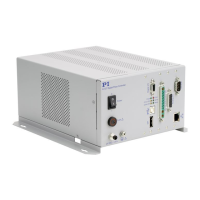User Manual
E727T0005, valid for E-727
BRO, 2019-06-28
Physik Instrumente (PI) GmbH & Co. KG, Auf der Roemerstrasse 1, 76228 Karlsruhe, Germany Page 26 / 240
Phone +49 721 4846-0, Fax +49 721 4846-1019, Email info@pi.ws, www.pi.ws
Important Components of the Firmware
The firmware of the E-727 provides the following functional units:
Firmware
Component
Description
Commands Communication with the E-727 can be managed using the commands of the PI General
Command Set (GCS; version 2.0). The GCS is independent of the hardware (controller,
stages connected).
See the GCS commands manual PZ281E for more information. You can find a list of
available GCS commands in the "Command Overview" section (p. 181).
The E-727 can also be controlled by an SPI master, see “SPI Interface” (p. 144).
E-727 models with EtherCAT interface can also be controlled by an EtherCAT master,
see “EtherCAT Interface” (p. 164).
command levels
Parameters reflect the properties of the E-727 and the connected stage and define the
behavior of the system (e.g. settings for the control algorithm and notch filters (p. 35)).
The parameters can be divided into the following categories:
Protected parameters whose default settings cannot be changed
Parameters that can be set by the user to adapt to the application
The write permission for the parameters is determined by command levels. The
current command level can be changed with the CCL command. This may require
entering a password.
For more information, see "Parameters" (p. 185).
The values of some parameters are stored on the ID chip (p. 39) of the stage. They are
loaded to the volatile and nonvolatile memory when the E-727 is switched on or
rebooted.
Control algorithm
for closed-loop
operation
For better position accuracy and performance, the E-727 can be operated in closed-
loop mode. A control algorithm (with sensor feedback) will then apply corrections to
the control value. For more information, see “Control Details” (p. 35).
Each axis can be controlled by a wave generator that outputs waveforms. The wave
generator is especially suited for dynamic applications in which periodic motions of the
axis are executed (p.
99).
Data recorder The E-727 contains a real-time data recorder (p. 65). This can record different input
and output signals (e. g. current position, sensor input, output current) from different
data sources (e. g.logical axes, input and output signal channels).
Macros The E-727 can save macros—command sequences can be defined and permanently
stored in the nonvolatile memory of the device via the macro function. A start-up
macro can be defined that is executed each time when the E-727 is switched on or
rebooted. This simplifies stand-alone operation (operation without a connection to the
PC). Further information can be found in the "Controller Macros" section (p. 121).

